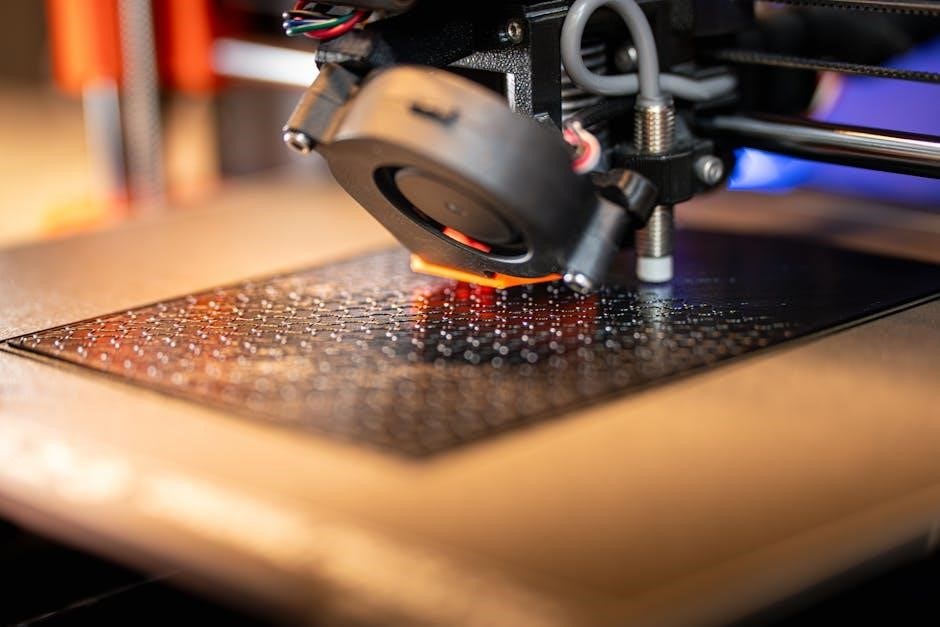The Science in Action 8 Textbook is designed to engage students through interactive activities and real-world applications, aligning with curriculum standards and fostering a deeper understanding of scientific concepts.
Overview of the Textbook Structure
The Science in Action 8 Textbook is organized into five comprehensive units, each focusing on specific scientific themes. These include Mix and Flow of Matter, Cells and Systems, Light and Optics, Mechanical Systems, and Fresh and Saltwater Systems. Each unit is divided into sections with clear objectives, activities, and assessments. The textbook also includes supplementary materials such as final exam and midterm review guides, unit learning packs, and online access to resources. This structure ensures a logical progression of learning, making it easy for students to follow and engage with the content.
Key Features and Benefits for Grade 8 Students
The Science in Action 8 Textbook offers engaging activities, real-world applications, and interactive content to cater to diverse learning styles. It provides hands-on learning opportunities, fostering curiosity and practical problem-solving skills. The textbook includes review guides and online resources, ensuring students can reinforce concepts and prepare for assessments. These features promote a deeper understanding of scientific principles and prepare students for future STEM challenges, making it an invaluable resource for Grade 8 science education.
Importance of Hands-On Learning in Science Education
Hands-on learning is a cornerstone of effective science education, allowing students to explore concepts through experiments and real-world applications. This approach fosters critical thinking, creativity, and collaboration, making complex ideas more accessible. By engaging in interactive activities, students develop practical skills and a deeper understanding of scientific principles. The Science in Action 8 Textbook emphasizes this method, encouraging students to investigate and discover through active participation, which enhances retention and prepares them for future STEM challenges.
Unit A: Mix and Flow of Matter
Unit A explores the properties of mixtures and solutions, introducing students to chemical and physical changes in matter. It emphasizes practical applications in everyday life, enhancing understanding through hands-on experiments and real-world examples. The Science in Action 8 Textbook provides detailed explanations and activities to engage students in learning about matter’s behavior and composition.
Unit A begins with an exploration of mixtures and solutions, defining their properties and differences. Students learn to identify and classify various types of mixtures, such as homogeneous and heterogeneous, and understand the concept of solutes and solvents. The Science in Action 8 Textbook provides interactive activities and real-world examples to help students grasp these fundamental concepts, making science engaging and accessible while aligning with curriculum standards.
Chemical and Physical Changes in Matter
Chemical and physical changes in matter are explored to help students understand how substances transform. Physical changes involve alterations in state or properties without creating new substances, while chemical changes result in new materials. The Science in Action 8 Textbook uses experiments and visual aids to illustrate these concepts, enabling students to identify and differentiate between the two types of changes through hands-on learning and practical examples. This foundation is crucial for further scientific inquiry in later units.
Applications of Mixtures in Everyday Life
Mixtures are integral to everyday life, from cooking and cleaning to personal care products. The Science in Action 8 Textbook highlights how mixtures are used in real-world scenarios, such as creating medications, fertilizers, and cosmetics. Students learn to identify and create mixtures through experiments, understanding their practical uses and importance in solving real-world problems. This hands-on approach helps students appreciate the relevance of scientific concepts in their daily lives and fosters a deeper understanding of matter’s properties and applications.
Unit B: Cells and Systems
Unit B explores the structure and function of cells, interactions between human body systems, and their impact on health, providing a comprehensive understanding of life processes.
Structure and Function of Cells
The Science in Action 8 Textbook delves into the fundamental biology of cells, exploring their structure, including the nucleus, mitochondria, and cell membrane, and their vital functions. Students learn how cells specialize and interact to form tissues and organs. The textbook uses detailed diagrams and interactive activities to explain processes like photosynthesis, respiration, and cell division. This unit emphasizes the importance of cells in sustaining life and maintaining overall health, preparing students for advanced biological studies.
Human Body Systems and Their Interactions
The Science in Action 8 Textbook explores how the human body’s systems, such as the skeletal, nervous, and circulatory systems, work together to maintain overall health. It examines how these systems interact to regulate bodily functions, respond to stimuli, and sustain life. The textbook provides detailed diagrams and case studies to illustrate how disruptions in one system can affect others. This unit helps students understand the interconnectedness of human physiology and its importance in maintaining balance and health.
Impact of Cells and Systems on Health
The Science in Action 8 Textbook highlights how cells and body systems influence overall health. It discusses how imbalances or failures in these systems can lead to diseases, such as cancer or diabetes. The textbook emphasizes the importance of understanding cellular functions and system interactions to prevent and manage health disorders. By exploring real-world examples, students gain insights into maintaining bodily harmony and promoting well-being through lifestyle choices and medical interventions.

Unit C: Light and Optics
This unit explores the properties of light, its behavior, and optical instruments. Students learn about reflection, refraction, and the applications of light in real-world technologies and everyday life.
Properties of Light and Its Behavior
Light exhibits unique properties, including reflection, refraction, and diffraction, which shape its behavior in various environments. Reflection occurs when light bounces off surfaces, while refraction involves bending through mediums like water or glass. The speed and wavelength of light change during refraction, explaining phenomena like rainbows. Understanding these principles is crucial for optical technologies and everyday observations, such as why objects appear distorted in water or how mirrors work. These concepts form the foundation for exploring optical instruments and their applications.
Optical Instruments and Their Applications
Optical instruments like telescopes, microscopes, and binoculars manipulate light properties to enhance observation. Telescopes allow exploration of distant celestial objects, while microscopes reveal microscopic details. Cameras capture images by focusing light onto sensors. These tools rely on principles such as magnification, resolution, and refraction. Understanding their operation bridges scientific concepts with practical applications, enabling advancements in astronomy, medicine, and daily photography. This chapter explores how these instruments function and their real-world impacts.
Real-World Uses of Light and Optics
Light and optics play a crucial role in everyday life and advanced technologies. Applications include medical imaging, fiber-optic communications, and LED lighting. Optical fibers transmit data at high speeds, while lasers enable precise cutting and welding. Sunglasses and contact lenses utilize optical principles to correct vision. Even everyday tools like cameras and binoculars rely on light manipulation. These technologies demonstrate how understanding light and optics transforms industries and enhances daily life, making it an essential area of study.

Unit D: Mechanical Systems
Mechanical systems introduce students to simple machines, mechanisms, and energy transfer. This unit explores how energy is transformed and used efficiently in everyday technologies and devices.
Simple machines and mechanisms form the foundation of mechanical systems. Students explore levers, pulleys, gears, and inclined planes, understanding how they reduce effort and improve efficiency. The textbook explains how these basic components work together in complex systems, emphasizing their role in transforming energy and motion. Real-world applications, such as engines and machinery, illustrate the practical importance of these concepts in everyday technologies. This unit builds a strong understanding of mechanical principles and their societal impact.
Energy Transfer and Efficiency in Systems
Energy transfer and efficiency are critical concepts in understanding how mechanical systems operate. The textbook explores how energy is transformed and transferred within systems, highlighting losses due to heat, sound, and friction. Students learn to calculate efficiency and analyze its impact on system performance. Real-world examples, such as engines and bicycles, demonstrate the practical importance of optimizing energy use. This section emphasizes the role of energy management in improving technological designs and reducing waste.
Designing and Building Mechanical Models
Students learn to design and build mechanical models, starting with blueprints and selecting appropriate materials. They assemble and test prototypes, analyzing performance and efficiency. This hands-on approach fosters problem-solving skills and creativity. Real-world applications, such as bridges or robots, illustrate practical uses of mechanical systems. The textbook provides detailed guides and online simulations to support the design process, ensuring students gain practical experience in engineering and innovation.

Unit E: Fresh and Saltwater Systems
This unit explores freshwater and saltwater ecosystems, focusing on their unique characteristics and interactions. Students examine the roles of organisms within these systems and their environmental impacts.
Water Cycle and Its Importance
The water cycle, a vital process, involves the continuous movement of water on, above, and below Earth’s surface. It includes evaporation, condensation, precipitation, and collection. This cycle sustains life, regulates Earth’s climate, and maintains aquatic ecosystems. Understanding its importance helps students appreciate water conservation and its role in shaping environments. The Science in Action 8 Textbook provides detailed diagrams and activities to explore this essential process, ensuring students grasp its significance in balancing nature and human needs.
Ecosystems in Fresh and Saltwater Environments
The Science in Action 8 Textbook delves into the unique characteristics of freshwater and saltwater ecosystems, exploring the diverse life they support. Freshwater ecosystems, such as rivers and lakes, differ from saltwater environments like oceans and estuaries in terms of flora and fauna. The textbook emphasizes the importance of understanding these ecosystems, highlighting how they sustain biodiversity and support aquatic life. Through detailed explanations and activities, students gain insights into the interactions within these environments and their role in maintaining ecological balance.
Conservation and Management of Water Resources
The Science in Action 8 Textbook emphasizes the importance of conserving water resources through sustainable practices. It explores strategies to reduce waste, promote efficient use of water, and protect freshwater and saltwater ecosystems. Students learn about water purification processes, the impact of human activities on water quality, and the role of policies in managing water resources. The textbook encourages students to apply scientific knowledge to develop solutions for water conservation challenges, fostering environmental stewardship and responsibility.

Additional Resources and Study Materials
The Science in Action 8 Textbook provides access to supplementary materials, including final exam and midterm review guides, unit learning packs, and online resources for concept reinforcement.
Final Exam and Midterm Review Guides
The Science in Action 8 Textbook offers comprehensive final exam and midterm review guides to help students prepare for assessments. These resources are available in PDF format, providing practice questions, concept summaries, and key term reviews. Designed to align with the textbook content, they cover all units, including Mix and Flow of Matter, Cells and Systems, and Mechanical Systems. Students can access these guides online, ensuring they are well-prepared for evaluations and retain a strong grasp of scientific principles.
Unit Learning Packs for Concept Reinforcement
The Science in Action 8 Textbook provides Unit Learning Packs to reinforce concepts covered in each unit. These packs are available as downloadable PDFs and include review questions, summaries, and activities. They focus on key topics like Mix and Flow of Matter, Cells and Systems, and Mechanical Systems. Designed to support independent study, these resources help students master scientific principles and prepare for assessments. They are accessible online, ensuring convenient access for Grade 8 students.
Online Access to Textbook and Supplementary Materials
The Science in Action 8 Textbook and its supplementary materials are available online, offering students and educators convenient access to learning resources. The digital version of the textbook can be downloaded as a PDF, along with unit-specific guides, review packs, and interactive activities. This online access supports flexible learning, allowing students to study at their own pace and review concepts like Mix and Flow of Matter or Light and Optics anytime, anywhere. Supplementary materials enhance engagement and understanding.
The Science in Action 8 Textbook provides a comprehensive education in Grade 8 science, fostering critical thinking and practical skills through engaging content and real-world applications.
The Science in Action 8 Textbook equips students with essential scientific knowledge and skills, covering key concepts such as mixtures, cells, light optics, and mechanical systems. Through hands-on activities and real-world applications, students develop critical thinking, problem-solving, and scientific inquiry abilities. The textbook emphasizes practical learning, preparing students for further STEM exploration and fostering a deeper understanding of natural phenomena and their everyday applications.
Encouraging STEM Exploration Beyond the Classroom
The Science in Action 8 Textbook inspires students to explore STEM beyond the classroom through interactive activities and real-world applications. By engaging in hands-on projects and collaborative learning, students develop a passion for science, technology, engineering, and math. The textbook’s resources, such as Unit Learning Packs, encourage independent study and creativity, helping students connect classroom concepts to everyday life and fostering a lifelong interest in STEM fields.
